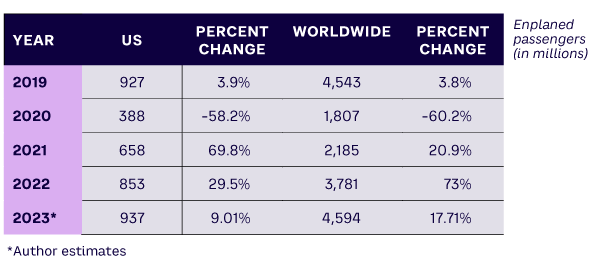AMPLIFY VOL. 36, NO. 5

Airports are microcosms of cities. In the early 2000s, the term “aerotropolis” was coined: a metropolitan subregion with infrastructure, land use, and economic activity centered around an airport. Like cities, airports usually have defined utilities, roadways/streets, commercial regulations, and special construction permits.
Airports often have their own particular accounting needs (somewhat like retail entities), utilities, asset management requirements, personnel requirements, and management hierarchy. Some US airports (like those in San Francisco, Philadelphia, Atlanta, Denver, and Chicago) have a city/county government hierarchy; others (like those in New York City, Los Angeles, Dallas, Toronto, and Orlando) operate as their own authority. In aviation circles, it’s usually accepted that all airports, regardless of management model, should run at a surplus — bringing in more revenue than their expenses. Because airports are considered public sector entities, we use the term “surplus” rather than “profit.”
What is less known is that the surplus is generated by non-aeronautical activities (concessions, car rental, parking, hotels, advertising, and other property uses), rather than aeronautical revenues. At larger airports, in my experience, revenues for these commercially oriented activities can account for 70% or more of total revenue, with aviation revenue (e.g., airline fees) accounting for around 30%. In a sense, airports are like urban or suburban shopping districts that happen to have an aviation component.
In 2019, enplaned passenger numbers (one key performance indicator) peaked, and airport success stories proliferated. It seemed as though just about every airport had new gates, a new terminal, new concessions, or some other renovation in progress, including Orlando International Airport’s Terminal C1 and New York’s LaGuardia Airport’s billion-dollar renovation.2
In 2020, airport economic development and the industry’s basic business model were severely challenged by the pandemic. Associations like the Airport Council International, the American Association of Airport Executives, the International Civil Aviation Organization, and the International Air Transport Association (IATA) and their member airlines, airports, and affiliated vendors pivoted to address the precipitous drop in air travel. Through interviews with individuals with deep airport knowledge, this article strives to answer the following:
-
How were airport economic models able to flex during the pandemic?
-
Is there a success story that can serve as a model for other airports and other public sector entities for future resilience?
-
How has the push toward sustainability affected airport management, and how might it drive the public sector in the future?
-
What technology investments can be made for long-term operational efficiencies? How will airports of the future be able to exert more control over their campuses through autonomous electrified vehicles and sustainable aviation?
-
How can the industry take advantage of artificial intelligence and analytics going forward?
Remarkable Rebound
Both US and international enplaned passenger statistics have shown a consistent climb out of the hole caused by the pandemic (see Table 1).

Note that although the 2023 estimates are my calculations, they are rooted in expert predictions that passenger numbers will soon return to 2019 levels. Willie Walsh, Director General of IATA, says that by the end of 2023, most regions will reach or exceed pre-pandemic demand levels.3 According to IATA, international air travel continues its recovery (albeit below the US’s recovery slope), despite the fact that domestic markets are still strongly dependent on COVID-19 policies and pandemic-related developments. Generally, the recovery in international air travel has been strong, but Asia-Pacific still lags, following a prolonged shutdown and only more recent market reopenings, especially in some of the largest markets.4
Airports were abruptly impacted by the pandemic, but there was a certain confidence about maintaining a level of service, the necessity of air travel in our lives, and a post-pandemic rebound. IATA’s Annual Review 2022 put it this way:
Looking back at the pandemic, we can point to our service with pride ... airlines kept the world connected. Airlines kept vital supply lanes open to deliver lifesaving vaccines and medical supplies. And they operated to the highest levels of safety throughout. Over and over, the aviation workforce rose to the occasion. In fact, the importance of aviation was made absolutely clear by the pandemic restrictions. People recognized that their quality of life deteriorated and economies suffered.5
Most organizations experiencing a 60% drop-off in customers, as airports did in 2020, would have simply ceased operations. Airports were able to survive through a combination of adjustments that demonstrated their resilience. For example, they quickly made changes corresponding to airline flight schedules, including staffing, gate and terminal openings/closures, parking systems, and concession management. Some airports even continued their expansion plans, and Orlando Airport’s belief in the need for its new terminal was validated. “Orlando International Airport saw nearly 10 million more passengers in 2022 than the year before,” says Kevin Thibault, CEO of the Greater Orlando Aviation Authority. “These numbers validate our strong belief that Terminal C was more than needed to meet projected demand. By continuing to build during the pandemic, we are now well positioned for the future growth and economic expansion of the Central Florida region.”6
Reconfiguring many administration aspects allowed airports to stay open while other businesses closed. In essence, airports were able to tread water until travel restrictions were eased and they could revert to business as usual. Assistance from the US government is helping with the recovery, including the Investment in the Infrastructure and Jobs Act (IIJA), which contains US $15 billion for airport infrastructure funding.7 Money from IIJA can be invested in runways, taxiways, safety, and sustainability projects, as well as terminal, airport-transit connections, and roadway projects.
A Success Story
Airports followed the historic downturn with a consistent recovery, overcoming difficulties like fuel price increases, personnel shortages (pilots, crews, and support staff), and a demand for travel that sometimes outpaced flight supply. Not to mention that much of the world continues to experience pandemic-related reduced flight schedules as well as a general recession, lockdowns in China, and a war in Ukraine.
To get a firsthand view into how airports were able to survive the downturn, rebound, and move forward, we spoke with Phillip Washington, CEO of Denver International Airport, which currently ranks third in the world in enplaned passengers.
Denver International Airport had a quicker recovery than many other airports because it’s less reliant on international and leisure travelers, Washington told us. The airport experienced declines in surplus, but airline revenues were roughly the same.
Interestingly, recovery was not the only objective for Denver. Washington and his team created a strategic plan called “Vision 100” that set targets for handling 100 million enplaned passengers in five to eight years (the airport was designed for 50 million).8 Government funding in the hundreds of millions of dollars is part of the plan, but there’s more to it. The plan also aims to:
-
Empower people. Encourage internal employees and vendors of all sizes to be innovative. To this end, the airport has established a Center of Equity and Excellence in Aviation (CEEA) that aims to tackle the workforce issues facing all transportation sectors and create a starting point for innovation. CEEA is focused on three key areas: a business development training academy, career pathways, and a research and innovation lab.
-
Improve capital program management. Grow the infrastructure by being efficient and proper stewards of governmental grants allocated to the airport while interacting with the agencies within the City and County of Denver.
-
Improve asset management. Ensure that all assets are maintained to achieve their economic lifespan, adhere to preventive maintenance schedules, and ensure safety for employees and passengers alike. Within this pillar, there is a major component of enhancing the customer experience and another aimed at greenhouse emissions mitigation.
-
Expand global connections. The airport has formed a connection with Ethiopia that coincides with the US having the largest diaspora community of Ethiopians in the world (approximately 500,000). Growth in air cargo and domestic flights are also part of this pillar.
Washington told us he wants to examine how airports can identify technology trends and look for applications that can be quickly adopted by airport staff to propel them, as a team, to become a leading authority. One potential area is using predictive analytics, especially in the third pillar (asset management), where early warnings can mitigate or eliminate reactive maintenance. Decreasing outages of all kinds is a clear goal of any customer-facing enterprise, airports among them.
Improving Sustainability & Testing Technology
The aviation industry continually strives to do better with regard to sustainability. IATA members (airlines and airports) have resolved to achieve net-zero carbon emissions by 2050.9 Airports like Denver International see value in having connected autonomous vehicles handle the 24/7/365 routes for ever-present hotel and rental car shuttles. In fact, because of their route monotony, airport shuttles are better candidates for autonomy than vehicles with even slight route variations. In addition to being autonomous, airport shuttles could be electrified to provide a cost-effective, eco-friendly customer experience. Denver International Airport is going even further with the planned construction of a consolidated rental car facility that should reduce the number of shuttles transporting customers to and from rental car parking lots and terminals for more sustainable operations.
When it comes to general technological transformation, airports are excellent proving grounds. Potential pilots include smart parking, chatbots (for the type of virtual assistance increasingly seen in the retail industry), sustainable fuels, cybersecurity, customer experience, and private networks.
The latter could enhance a number of applications like airport operational systems (gate and terminal management), customer-facing systems (flight information displays, baggage-handling systems), and tenant-facing systems (concession, car rental, hotel, and airline). Additionally, the large amounts of data contained in an airport’s Internet of Things could be facilitated by a fast, highly secure, reliable communications backbone using a private 4G or 5G network.
Many airports are trying to solve traffic congestion exacerbated by the ride-share renaissance. Some airports have four or more lanes going around the airport that are now reduced to two due to drop-offs and pickups in the two lanes closest to the curb. High-occupancy vehicle lanes are one answer; automatic tolling for single-occupancy vehicles is another possibility.10
Of course, Denver is not the only airport with innovative sustainability solutions. The Chicago Department of Aviation’s (CDA) O’Hare Airport has used goats and other grazing animals to maintain dense scrub vegetation on its property. The grazing sites are outside the airfield fence, including hilly areas along Willow-Higgins Creek that are difficult to maintain with traditional landscaping equipment. The program helps CDA achieve many economic, operational, and environmental benefits, including:11
-
Providing a more efficient way of removing vegetation along steep embankments and rocky areas that are difficult to maintain with traditional mowing
-
Reducing habitat for wildlife that may be hazardous to airport operations
-
Reducing soil erosion and rutting from the use of heavy equipment
-
Reducing air pollution from gasoline-powered equipment
-
Reducing landscaping waste sent to landfills and air pollution from trucks hauling the waste
-
Clearing weeds and invasive species without the use of herbicides
-
Allowing US Department of Agriculture research on the effectiveness of the grazing herd on vegetation removal and wildlife changes resulting from grazing
Capitalizing on Resiliency & Expanding the Airport Model
Airports have become public sector stars. They are models of strategic resiliency, confidence, and positive attitude, often running more like a commercial enterprise than a public agency. They quickly recovered from recent socioeconomic downturns, demonstrating to public sector entities like cities, counties, and states how to run at a surplus and ignite economic development.
Denver International Airport, a clear model for the industry, is the economic engine for its metropolitan region, generating $33 billion a year, employing nearly 30,000 employees, and supporting nearly 260,000 jobs.12 Rather than rest on its accomplishments, it is planning to double its capacity, an achievement that would positively impact the region.
Beyond sheer economics, applying the guiding principles of Denver’s Vision 100 (below) to public sector entities nationwide could yield a level of resilience, confidence, and positivity for all:13
-
“Sustainability and resiliency. Our goal is to become the greenest airport in the world while ensuring that our actions and decisions foster a healthy and resilient organization.
-
Equity, diversity, inclusion, and accessibility. We are better when everyone is at the table and when we respect and listen to all viewpoints.
-
Operational excellence. We maintain focus on ensuring efficient and effective operations while collaborating with our partners to identify and address challenges and review our experiences, implementing improvements based on learning.
-
Enhancing the customer experience. This is our core business. We will work closely with our stakeholders to meet and exceed the needs and desires of our travelers.”
Other public sector entities could benefit from the airport model by:
-
Creating programs like CEEA to simultaneously promote equity and diversity
-
Enhancing communication infrastructure to promote telehealth, remote education, and telework
-
Promoting the citizen experience by deploying virtual assistants to help users navigate complex websites
-
Adopting and developing sustainability ideas like landscaping herds
-
Adopting electric and autonomous vehicles to mitigate traffic and reduce pollution
We can conclude lessons learned from airports can and should be extrapolated and redeployed into larger public sector settings. They have validated many innovations and proven to be valuable, controllable test sites.
References
1 Orlando International Airport Press. “Orlando International Airport Breaks 50 Million Passenger Mark for 2022.” Greater Orlando Aviation Authority, 3 February 2023.
2 “A Whole New LGA Nears Completion.” A Whole New LGA, accessed June 2023.
3 “IATA Annual Review 2022.” International Air Transport Association (IATA), accessed May 2023.
4 Karp, Aaron. “ACI Warns Asia-Pacific’s Airports Remain in Financial Distress.” Aviation Week Network, 12 April 2023.
5 International Air Transport Association (IATA) (see 3).
6 Orlando International Airport Press (see 1).
7 “Bipartisan Infrastructure Law — Airport Infrastructure.” US Federal Aviation Administration (FAA), accessed May 2023.
8 Murray, Jon. “Denver International Airport Ranks Third in the World — Again — for Passenger Traffic.” The Denver Post, 6 April 2023.
9 “Major Projects: Vision 100.” Denver International Airport, accessed May 2023.
10 IATA (see 3).
11 Menzano, Ralph. “Smartphone Toll Systems: Boost Revenue, Enable Congestion Control & Promote High-Occupancy Commuting.” Amplify, Vol. 35, No. 8, 2022.
12 “Grazing Herd.” O’Hare & Midway International Airports, accessed May 2023.
13 Denver International Airport (see 9).



